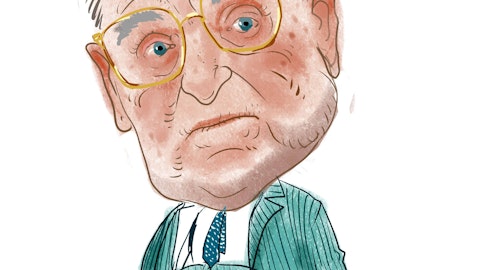But even with that said, I think the capital generation is so strong that any level of reasonable organic growth, I don’t think it outstrips the building of those ratios between the regular dividend, organic growth. And so that does leave us with buyback options, potentially, depending on if buybacks were — didn’t make sense, then we could always look at whether a special dividend makes sense. And then to your question, inorganic growth, I think that we’re — it feels like we’re in a time period like we were in mid-2020 where the M&A markets are kind of frozen. The math is very hard right now. I know there’s been a few things announced, but those aren’t healthy thriving franchises that would be of interest to us, we don’t feel like that it’d be additive to our long-term value, but that will change with the passage of time.
And so I do think that there’s going to be some opportunities to at least look at things. But as we’ve said before, the size company we are, the eight states that we’re in, there’s not a plethora of opportunities that move the needle for us. So we’d be very selective and disciplined about looking at any type of inorganic opportunities.
Chris McGratty: Great. Thanks for all the color. Appreciate it.
Operator: Thank you. One moment, please. Our next question comes from the line of Jeff Rulis of D.A. Davidson. Your line is open.
Jeff Rulis: Thanks. Good afternoon. I wanted to clarify, is it safe to assume a loan growth expectation would mirror your balance sheet growth expectation of no growth to 3% or possibly outstrip that?
Ron Farnsworth: Jeff, this is Ron. Good question. And yes, I mean, ideally, over time, you want the deposit growth to match the loan growth. And that’s our goal here over the course of 2024.
Jeff Rulis: Okay. So loan growth at maybe no growth, I just want to kind of pare that up, Clint, with kind of the field and that getting us out there. Is there a point where you’re kind of tamping down your kind of loan officers on, hey, we got to true it up with deposit growth. I’m just trying to get the assumptions underlying pretty limited growth and kind of meet that with kind of the team and you’re going on the anniversary of the merger close. I just want to kind of get the sense for feed under those folks and starting to produce pretty significant net growth.
Clint Stein: Yes, it’s a great question. It gets back to the response I had on inorganic growth. And when we think about — there — we’ve talked for the last couple of quarters about being relationship-centric. And in a QT-type environment, we’re where we’re holding back and being very restrained is on transactional real estate type things. Our C&I teams, small business bankers, I mean they’ve got a green light and the ability to go out. But I don’t think there’s a single banker in this company that doesn’t understand that — and I use the term banker purposely, we don’t have lenders, we have bankers and that they need to go get the full relationship, needs to come with deposits. And they’re not going to fund dollar for dollar.
I mean that’s not the nature of it, but that’s why we have our robust 300 strong retail network to help with the funding. But that’s where I think the optimism is. The integration is behind us. We’ve shut down the integration management office, and they’re ready, they’re on their front foot, and they’re ready to go play offense. And Tory, I don’t know if you have anything to add?
Tory Nixon: Yes. Jeff, it’s Tory. I would just maybe reiterate a little bit of Clint’s comments around just the sales force and the bankers in the footprint. There strong desire to grow market share to really — to manage what we have and keep what we have and continue to expand with what we have, but to grow market share. And that sometimes is a relationship that includes a loan and sometimes it’s a relationship where there’s no lending activity. With deposit only or deposit and core fee income relationship is very valuable and supports this local presence that Chris always talks about and this ability to grow their book of business. And our focus is definitely on the C&I side of the house. And as you can see in the growth in real estate, it’s been — it’s flat and in on purpose, and we’re pushing on the C&I front. And so we’ve got a lot of great bankers and great markets that are out pounding the pavement and looking to bring in new names into the bank.
Jeff Rulis: Appreciate it. I wanted to maybe hop over to the credit side of things and really kind of looking at that kind of the crosshairs going to FinPac. Thinking about, I think mid last year, we were kind of pointing to — maybe it was hopeful or some signs forming that those trucking losses would have lower. It looks like we’re bouncing back up. And I guess kind of over the course of ’24, if you think about losses in impact, is it safe to assume we could still be in that 5% to 6% for the full year? Or do you see any trend that we could kind of come off a cliff with that?
Frank Namdar: Jeff, yes, I do not expect that this trend goes all through ’24. I mean if we look at the loss curves and really the vintages that have caused this pain, the vintages were really the last half of ’21 and all of 2022. From a loss curve perspective, we’re through all of ’21, and we’re about halfway through ’22. So I believe we will see at the end of the second quarter, those losses start to tail off at a more rapid way than they have historically. And don’t forget, I mean, the fourth quarter is a tough barometer for collecting because of all the holidays that are during that quarter. And in this space, I mean, remember, I mean, FinPac is it may be a subsidiary of the bank and provides a valuable product set for the bank.
But at its core, it’s still a finance company and a finance company, this type of activity and what we’re seeing currently is not is not abnormal. And if you go out there and survey our competitors, they’re experiencing the exact same thing, even at a worse clip than we are. What is encouraging is that it is isolated to the trucking portfolio, and we do see the light through the data that we have, that there is an end in sight, and I do believe it will be halfway through this year.
Jeff Rulis: Got it. Just to kind of get into that vintage, and I appreciate the color there. That’s the thought that as we moved into the back half of ’23 and hopeful of a decline, was it that you got into some of those ‘22 vintages that were like, wow, this is also troublesome. Is that why sort of the extended…
Frank Namdar: Yes. I mean — and we were coming out of ’21, and we did see that ’22 was also displaying some of the elevated loss characteristics. And so we kind of had a feeling that it would be a long drug out process for getting back to that 3.5% clip. But we do see it in the early returns, I will tell you, for the ’23 vintage, they’re very positive. So that is encouraging. The tweaks that we’ve made to the model and the criteria really in the portfolio as a whole, but in particular, the trucking portfolio has really — seems to be paying off in the ’23 vintage.
Jeff Rulis: Great. And then one last one. Ron, I’ll take another crack. I didn’t really hear a response on the margin trajectory. I know it resides with deposit success. But I guess, put it more clearly, do you expect more compression in the first-half of ‘24 versus the second-half when you layer on potential rate cuts, your 3 basis points of cuts?
Ron Farnsworth: That’s correct. Just given the fact that we’ve got that conservative estimate in there for the deposit betas. And that will really be a driver of — if we do see the rates down environment, I expect we’ll outperform. I expect our betas will be above the 30% on the down. I mean they’re closer to like I said earlier, the 50% on the up. Overriding all of that, of course, would be what’s going on with just basic customer deposit flows. And you heard enough conversation on that point to date. So we’ll see how it plays out.




